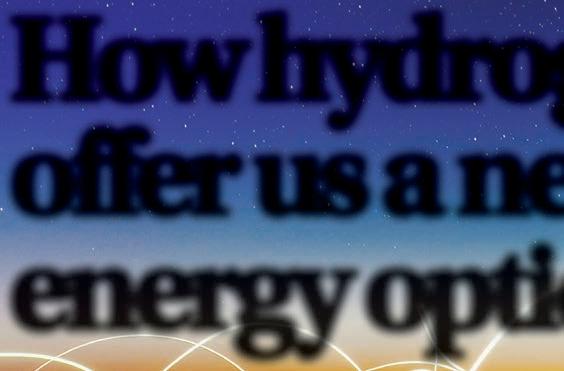
7 minute read
Health & Science

We all know from basic chemistry at school that hydrogen is the most common element in the universe, and has long been hailed as a clean and plentiful alternative energy source. But the easiest way to produce hydrogen fuel requires pure water, which can be hard to get ahold of — and will only become more di cult to source as droughts continue around the globe.
Advertisement
But, in a new study published in the journal Nature Communications, scientists have revealed a new way to churn out hydrogen fuel.
It happens that all you need is the humidity that’s naturally hanging in the air, scientists found, along with their new device that swallows moisture and spits out hydrogen and oxygen. eir method could spur hydrogen fuel production anywhere on the planet.
When hydrogen reacts with oxygen in electricity-generating fuel cells, it leaves only water behind — unlike fossil fuels, which emit pollutants in the process. Electricity then splits water molecules into hydrogen and oxygen gases, a process that’s known as electrolysis.
Hydrogen research aims to harness solar energy or other renewables to create hydrogen fuel from water, all without harming the environment.
But this strategy “will need a signi cant amount of freshwater, and this can be a challenge in places where the water supply is a big issue,” says study author Gang Kevin Li, a chemical engineer at the University of Melbourne in Australia.
More than a third of Earth’s land surface is arid or semiarid, but these areas nevertheless manage to support roughly 20% of the world’s population, Li and his colleagues note.
Freshwater is extremely di cult to access for survival purposes in these dry


ere is yet another breakthrough announced in the treatment of some cancers. e growth of metastatic tumours in mice has shown to be preventative in a new therapeutic approach by forcing cancer cells into a dormant state in which they are unable to proliferate. e study, published in the Journal of Experimental Medicine (JEM), could lead to new treatments that prevent the recurrence or spread of various cancer types, including breast cancer and head and neck squamous cell carcinoma (HNSCC).
Many cancer patients relapse, often years or decades after their initial treatment, and develop new tumours that regrow in the same location or metastasize (spread) to other parts of the body. ese secondary tumours are often resistant to treatment and are produced by individual tumour cells that may remain dormant for long periods before being reac-

How hydrogen may offer us a new, clean energy option
regions, let alone to produce hydrogen fuel. Pollution, climate change, and factories that gobble up water only exacerbate water scarcity concerns.
And ,while desalination can free up seawater for hydrogen fuel production in coastal areas, this signi cantly increases the cost and complexity of the process.
“Most areas on Earth with high solar and wind potential lack freshwater,” Li says. “For example, a desert is deemed a good place for solar power, but has no fresh water.”
Previously, Li researched ways to purify gases from smokestacks to capture the carbon dioxide within, so he got a handle on how to catch gases from the air. So when Li’s research expanded to hydrogen production and the hunt for fresh water, re ecting on his past work gave way to a eureka moment.
To see if his concept would work in water-scarce, lowhumidity regions, Li checked the relative air humidity in Alice Springs, an Australian town next to the famous Uluru Rock in the deep of the country’s central desert.
He observed that Alice Springs in Australia had an average relative humidity of 20 percent throughout the year. Since this was far more moisture than they needed, electrolysis from thin air was de nitely possible — even in some of the harshest environments.
In their experiments, the researchers used renewable energy from solar and wind power to operate a device
Yet another break in cancer treatment
tivated to start proliferating again. Patient relapse might therefore be prevented if researchers could nd a way to keep remaining cancer cells in a dormant state. In a previous study, Maria Soledad Sosa from the Icahn School of Medicine at Mount Sinai and Julio A. AguirreGhiso, now at Albert Einstein College of Medicine, discovered that the ability of cancer cells to remain dormant is controlled by a protein called NR2F1. is receptor protein can enter the cell nucleus and turn numerous genes on or o to activate a programme that prevents the cancer cells from proliferating. NR2F1 levels are usually low in primary tumours but are elevated in dormant disseminated cancer cells. Levels of the NR2F1 protein then decline once more when cancer cells start proliferating again and form recurrent or metastatic tumours.
“We therefore thought that activating NR2F1 using a small molecule could be an attractive clinical strategy to induce cancer cell dormancy and prevent recurrence and metastasis,” Aguirre-Ghiso explains.
In the new JEM study, Sosa and Aguirre-Ghiso’s teams used a computerbased screening approach to identify a drug, named C26, that could generate hydrogen fuel from water in the air with an e ciency of about 95%.
In their experiments, the researchers used renewable energy from solar and wind power to operate a device that could produce hydrogen from water in the air with an e ciency of about 95 percent. e device in question is made of porous, spongy material that can take in moisture from the air, sort of like the silica gel packets found
that activates NR2F1. e researchers found that treating patient-derived HNSCC cells with C26 boosted the levels of NR2F1 and arrested cell proliferation. e researchers then tested whether C26 would prevent metastasis in mice. Animals injected with patient-derived HNSCC cells typically form large primary tumours that spread to the lungs after the original tumour is surgically removed.
Treatment with C26 reduced the size of primary tumours, and, after surgery, further doses of C26 completely blocked the growth of metastatic tumours. Instead, the rodent’s lungs contained just a few dormant disseminated cancer cells unable to proliferate even after cessation of the treatment. Sosa and Aguirre-Ghiso’s teams determined that, by activating NR2F1, C26 forces cancer cells into a long-lived state of dormancy characterised by a unique pattern of in our beef jerky packaging. en, electrodes at either end turn the molecules into hydrogen and oxygen.
“ is work reported the rst technology that can directly produce high-purity hydrogen from the air without using a liquid water feed,” Li says. “ is technology can potentially enable green hydrogen in areas su[ering from water scarcity, such as Middle and West Asia, North Africa, Central Australia, and West America, which are also areas abundant in solar power.”
In lab conditions, the new method could operate for more than 12 consecutive days and create hydrogen from the air with as little as 4% humidity in lab conditions. In comparison, in the drought-ridden Sahel region that spans east from Senegal to Eritrea, the average relative humidity is about 20%. e scientists also tested their invention outside at the University of Melbourne campus, where temperatures varied from around 70 to 100 degrees Fahrenheit and the relative humidity ranged from 20 to 40 percent. On a warm sunny day, ve modules that each had about 7.84 square centimetres of surface to yield hydrogen from the air could spawn 130 cubic feet of fuel per day. e potential environmental impact of this device harvesting water from the air is likely negligible, Li notes. For instance, to supply hydrogen to all the residents and visitors at Alice Springs using the team’s technology, the relative humidity of the air in their surroundings would only fall by 0.02%.
So what’s next? e scientists have just been o ered venture capital cash to scale up their research. In the future, they aim to test a 107-square-foot version of their device in harsh environments, such as a desert, frozen zone, or stormy area, Li says.
gene activity. Cancer patients whose tumours display a similar pattern of gene activity tend to go longer without relapsing, suggesting that inducing this dormancy program with C26-type drugs could be e ective in humans.
“Drugs that activate NR2F1 might be particularly useful in breast cancer,” says Sosa. “NR2F1 is highly enriched in ER-positive tumours when compared to ER-negative tumorus, and activating NR2F1 might be able to suppress reawakening of dormant cancer cells kept in that state by anti-estrogen therapies.”
However, because C26 treatment elevates the levels of NR2F1, the approach may also be useful for other cancers with inherently low levels of the receptor protein.
“Overall, our study reveals a mechanism-based and rationally designed strategy to exploit NR2F1-activated dormancy as a therapeutic option to prevent metastatic relapse,” Aguirre-Ghiso says.







